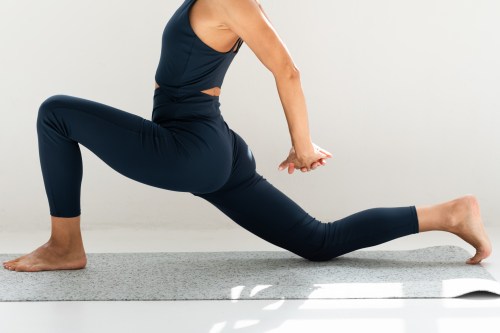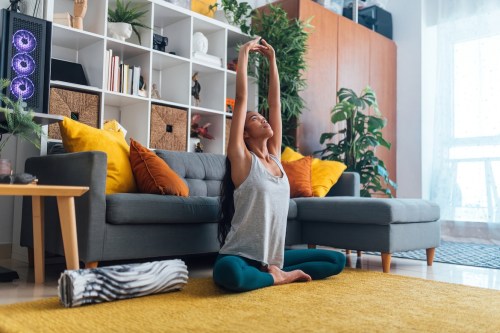There are only so many hours (um, minutes) in the day you’re going to devote to exercise, we get it. So when you make the time to work out, you want that sweat session to work for you. Yes, in an ideal world, everyone would get the minimum 150 minutes of cardio and two strength-training workouts a week recommended by the Centers for Disease Control and Prevention. But in reality, wouldn’t it be nice if your favorite cardio workout, like indoor cycling, also counted as leg day?
Experts in This Article
Life Time group fitness and cycling instructor in New York and New Jersey
We spoke to certified personal trainer and cycling coach Joseph David, ISSA-CPT, a Life Time group fitness and cycling instructor in New York and New Jersey, to find out if a cycling class is enough to work your legs and how to make indoor cycling even more of a lower-body burn.
Which muscles does cycling work?
Cycling does, of course, work your leg muscles. Those pedals won’t move themselves, after all! You can expect to work your quads (the muscles on the fronts of your thighs), your glutes (the muscles of your butt), and your calves (the muscles on the backs of your lower legs), David says.
“As you lift your leg from your core, you’re going to work your quads, and as you press down on the pedal, you’re firing up your glutes,” he says. If you’re wearing cycling shoes that strap into the pedals, you also work your hamstrings more when you pull up on your pedal stroke, according to the Arthritis Foundation.
Extra bonus: Indoor cycling also works your abs: “Your core is engaged the entire class,” David adds.
“The real star of the show here is adding the resistance on a bike.” —Joseph David, ISSA-CPT
How does cycling compare to resistance training?
But even though cycling strengthens your leg muscles, targeted lower-body strength exercises — say, squats and deadlifts — are going to have a bigger effect if you’re really looking to build muscle.
According to a March 2015 review1 in Acta Physiologica Hungarica, cycling does increase leg muscle size, but any visible changes happen more slowly than the growth you’d notice from traditional strength training workouts.
Plus, indoor cycling is linear; it only involves moving in one plane. Lower-body moves like lateral lunges and lateral step-ups work your leg muscles in different planes of motion, which helps build balanced strength by working different muscles in different ways, according to USA Cycling.
If you really want to build leg muscle quickly, it will help to add some lower-body strength days to your workout routine. But keep in mind those sessions will likely make you a better cyclist over time, according to a March 2021 study2 in the Journal of Functional Morphology and Kinesiology.
And vice versa: Your cycling might also help your strength training, David says. Pedaling your legs loosens up your hips and fires up your glutes, meaning you might be more comfortable moving through your full range of motion on days when you’re lifting weights, he says.
Will cycling alone strengthen your legs?
You absolutely will build some leg strength from only doing cycling and no strength training. If that’s your plan, make sure you’re riding with resistance. “The real star of the show here is adding the resistance on a bike,” David says. Your muscles will have to work harder to turn the pedals and will adapt and grow stronger in the process. “I like to say hustle to get the muscle.”
You might also want to stay seated in the saddle to pedal rather than standing up on the bike. When you stand up, you’re using more of your own body weight to push against the resistance on the pedals, David says. Sitting down isolates your legs more and may make them stronger over time.
Aim to take an indoor cycling class at least four times a week if you’re eager to see results, he says. That leaves time for separate strength-training workouts, if you decide to lift weights. If not, you might even be able to cycle six times a week to really keep yourself consistent and on the path to progress, he says.
If you’re really looking for a challenge and you’re an experienced exerciser already, experiment with doing some lower-body strength training before an indoor cycling class. “It really burns those legs out,” David says.
No matter how you plan to exercise, if you want to build muscle and strength, you have to push your limits, David adds. Your workouts should feel challenging and get even harder over time as you grow more comfortable, a concept called progressive overload. “Even if it’s [picking up weights that are] one pound heavier, one pound is greater than the last time you did it,” he says. “It’s about adding the resistance slowly, sticking to it, and believing that you’re already strong.”
Ozaki H, Loenneke JP, Thiebaud RS, Abe T. Cycle training induces muscle hypertrophy and strength gain: strategies and mechanisms. Acta Physiol Hung. 2015 Mar;102(1):1-22. doi: 10.1556/APhysiol.102.2015.1.1. PMID: 25804386.
↩︎Vikmoen O, Rønnestad BR. A Comparison of the Effect of Strength Training on Cycling Performance between Men and Women. J Funct Morphol Kinesiol. 2021 Mar 17;6(1):29. doi: 10.3390/jfmk6010029. PMID: 33803041; PMCID: PMC8006227.
↩︎
Sign Up for Our Daily Newsletter
Get all the latest in wellness, trends, food, fitness, beauty, and more delivered right to your inbox.
Got it, you've been added to our email list.











